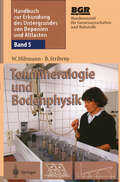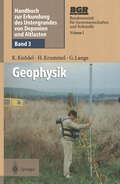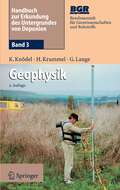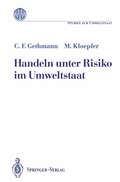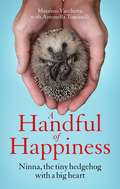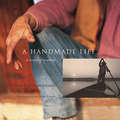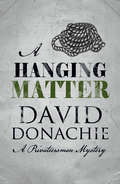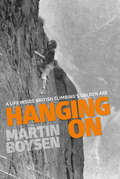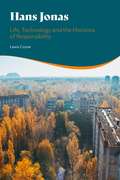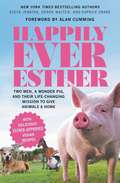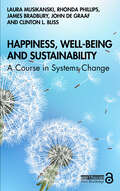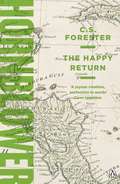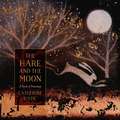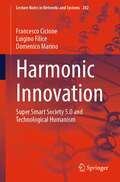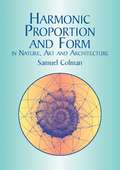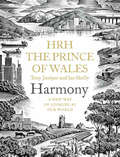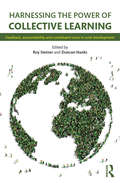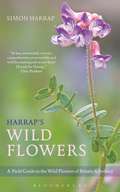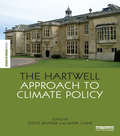- Table View
- List View
Handbuch zur Erkundung des Untergrundes von Deponien und Altlasten: Band 5: Tonmineralogie und Bodenphysik
by Werner Hiltmann Bernhard StribrnyHandbuch zur Erkundung des Untergrundes von Deponien und Altlasten: Band 3: Geophysik
by Klaus Knödel Heinrich Krummel Gerhard LangeIn diesem Band sind die geophysikalischen Methoden und Werkzeuge dargestellt. Mit einer leichtverständlichen, durch Prinzipskizzen veranschaulichten Methodenbeschreibung und Angaben zu den Anwendungsmöglichkeiten sollen auch fachfremde Leser angesprochen werden. Vorwiegend in den Grundlagenkapiteln findet der Geophysiker das spezielle Wissen, das er zum Einsatz der Methode oder zur Beurteilung von Untersuchungsergebnissen benötigt. Erläutert werden auch die Meßprinzipien und der Stand der Meßgerätetechnik, die Anlage und Durchführung der Feldarbeiten, die Bearbeitung und Interpretation der Meßdaten, die Qualitätssicherung sowie der personelle, technische und zeitliche Aufwand. Beispiele aus der Erkundungspraxis veranschaulichen die Anwendungsmöglichkeiten der Methoden.
Handbuch zur Erkundung des Untergrundes von Deponien und Altlasten: Band 3: Geophysik
by Klaus Knödel Heinrich Krummel Gerhard LangeDieses Handbuch besteht aus insgesamt neun Einzelbänden. Sechs Bände behandeln die Themen Geofernerkundung, Strömungs- und Transportmodellierung, Geophysik, Hydrogeologie/Geotechnik, Tonmineralogie und Bodenphysik sowie Geochemie. Drei weitere Bände geben Handlungsempfehlungen für ein stufenweises Vorgehen bei der Erkundung von Deponie- und Altlastenstandorten, Fallbeispiele aus der Erkundungspraxis sowie einen Leitfaden zur interdisziplinären Erkundung und Bewertung von Quartärsedimenten als geologische Barrieren. Damit wird allen, die in Behörden und Firmen oder in der Wissenschaft an den Problemen des Umweltschutzes arbeiten, ein umfassendes Werk zur Verfügung gestellt, mit dem geowissenschaftliche Erkundungsarbeiten ökologisch wirksam und ökonomisch effizient durchgeführt werden können. In dieser aktualisierten Neuauflage des Bandes Geophysik werden die geophysikalischen Methoden und Werkzeuge zur Erkundung und Beschreibung des Untergrundes von Deponien und Altablagerungen dargestellt. Das breite Methodenspektrum wurde um die Kapitel Oberflächen-Nuklear-Magnetische Resonanz zur Grundwassersuche und NMR-Laborverfahren erweitert. Ein neues Kapitel In-situ-Überwachung stellt moderne Verfahren zur Langzeitüberwachung vor. Die Einschränkung des Anwendungsbereiches auf den "Untergrund von Deponien und Altlasten" bezieht sich vornehmlich auf die verwendeten Beispiele. Die dargestellten Methoden und Werkzeuge sind jedoch universell einsetzbar. Das Handbuch kann daher als ein Kompendium für die Umweltgeophysik verstanden werden. Es soll ausdrücklich kein Lehrbuch ersetzen. Dennoch wird es schon durch seine praxisorientierten Methodendarstellungen und zahlreichen Anwendungsbeispiele für die Aus- und Weiterbildung von Nutzen sein. Mit einer leicht verständlichen Methodenbeschreibung und Angaben zu den Anwendungsmöglichkeiten sollen auch fachfremde Leser angesprochen werden. Vorwiegend in den Grundlagenkapiteln findet der Geophysiker das Spezialwissen, das er zum Einsatz der Methode oder zur Beurteilung von Ergebnissen benötigt. Erläutert werden auch die Meßprinzipien und der Stand der Meßgerätetechnik, die Anlage und Durchführung der Feldarbeiten, die Bearbeitung und Interpretation der Meßdaten, die Qualitätssicherung sowie der personelle, technische und zeitliche Aufwand. Beispiele aus der Erkundungspraxis veranschaulichen die Anwendung der Methoden.
Handeln unter Risiko im Umweltstaat (Ladenburger Kolleg Studien zum Umweltstaat)
by Carl F. Gethmann Michael KloepferDer Preis für Wohlstand und Funktionsfähigkeit der modernen Industriegesellschaft besteht in dem Eingehen von sozialen, technischen und ökologischen Risiken. Diese Risiken werden in der Bevölkerung unterschiedlich bewertet. Dabei unterscheidet sich häufig das subjektive Risikoempfinden von der objektiven Risikobewertung. Die hierzwischen entstehende Lücke klafft weit auseinander und erschwert eine rationale Diskussion über die Bewertung von Risiken. Um sie zu schließen, bedarf es einer vertiefenden Auseinandersetzung über die Methodik der Risikobewertung, zu der hier aus ethischer wie juristischer Sicht ein Beitrag geleistet werden soll. Wenn sich der Staat als Umweltstaat unter Berufung auf (tatsächliche oder vermeintliche) Risiken, die es einzudämmen gelte, neue Eingriffsbefugnisse in die Rechte seiner Bürger verschafft, wird staatliches Handeln unter Unsicherheit zu einem rechtsstaatlichen Problem, zu dessen Bewältigung der vorliegende Band beitragen soll.
A Handful of Happiness: Ninna, the tiny hedgehog with a big heart
by Massimo VacchettaThe heart-warming story of how a tiny hedgehog helped one man find hope. 'Could you look after it for a couple of days? . . .' So begins the extraordinary friendship between veterinarian Massimo, who is at a low spot in his life, and a tiny, orphaned hedgehog. Only a few days old, covered with soft, white quills and mewling quietly, this little creature will turn around his life forever. Through the sheer force of Ninna's personality - curious, playful, affectionate - and the sudden, unexpected paternal protectiveness he feels nursing her back to health, Massimo reconnects with the world - and finally begins to feel like home. But as Ninna wakes from her first hibernation, she grows up, like any teenager, longing for freedom. A creature of the wild, she craves the free range of the woods beyond Massimo's house. Massimo must accept that Ninna is ready to move on . . . but one little hedgehog saved and released into her natural habitat is a new beginning for Massimo: setting up a sanctuary for the injured, orphaned, fragile - but with a will to live so strong it is truly contagious.A Handful of Happiness is their funny and life-affirming story - a celebration of our favourite prickly wildlife creature, which will make you laugh and cry. Perfect for animal lovers and fans of A Streetcat Named Bob, Arthur, Finding Gobi and Monty Don's Nigel.
Handmade Houses and Feeders for Birds, Bees, and Butterflies
by Michele McKee-OrsiniThese handmade birdhouses and feeders, bee hotels, and butterfly and ladybird homes will bring welcome visitors to your garden. Handmade Houses and Feeders for Birds, Bees, and Butterflies features 35 beautiful havens to build to attract more wildlife into your garden. Each house is beautifully designed, with colourful details, but is also perfectly adapted for its intended inhabitants. There are birdhouses you can hang up or place on stands, and a bee house you can 'plant' in your flowerbed. There are also feeders for birds, and homes for butterflies and ladybirds. With her trademark attention to detail, Michele McKee-Orsini has designed a gorgeous collection of miniature palaces for the wildlife that we should all be encouraging into our gardens. Michele takes you through the basic woodworking and decorating skills you will need, and the step-by-step project instructions, clear artwork, and stunning photography will all inspire you to build your own havens for our flying friends. Handmade Houses and Feeders for Birds, Bees, and Butterflies is a compilation of previously published favourites.
A Handmade Life: In Search of Simplicity
by William Coperthwaite Peter Forbes John SaltmarshWilliam Coperthwaite is a teacher, builder, designer, and writer who for many years hasexplored the possibilities of true simplicity on a homestead on the north coast of Maine. In the spirit of Henry David Thoreau, Emily Dickinson, and Helen and Scott Nearing, Coperthwaite has fashioned a livelihood of integrity and completeness-buying almost nothing, providing for his own needs, and serving as a guide and companion to hundreds of apprentices drawn to his unique way of being. A Handmade Life carries Coperthwaite's ongoing experiments with hand tools, hand-grown and gathered food, and handmade shelter, clothing, and furnishings out into the world to challenge and inspire. His writing is both philosophical and practical, exploring themes of beauty, work, education, and design while giving instruction on the hand-crafting of the necessities of life. Richly illustrated with luminous color photographs by Peter Forbes, the book is a moving and inspirational testament to a new practice of old ways of life.
A Hanging Matter (Privateersman #3)
by David DonachieIt wasn't quite the homecoming ex-privateer Harry Ludlow had anticipated. Having cheated death and made a handsome profit into the bargain, Harry and his brother James expected their return home to be quiet - until they become embroiled in a fierce contest between smugglers in the English Channel.
Hanging On: A life inside British climbing's golden age
by Martin BoysenThe start of a love affair. 'I kicked off my shoes and prepared to climb in stocking feet, aware of an enormous sense of occasion as I laid hands on the rock and stepped up on the first rounded hold. It was not a hard climb but that was unimportant. I felt instinctively at home and at the finish experienced such a surge of happy elation that I knew then I was committed to climbing.' Martin Boysen's passion for crags and mountains springs from his deep love of nature and a strong sense of adventure. From his early days on rock as a Kent schoolboy after the war, he was soon among the most gifted climbers of his or any generation, famed for his silky technique. Boysen made a huge contribution to British rock climbing, especially in North Wales; he discovered Gogarth in the 1960s and climbed some of the best new routes of his era: Nexus on Dinas Mot, The Skull on Cyrn Las and the magisterial Capital Punishment on Ogwen's Suicide Wall. For more than two decades, Boysen was also one of Britain's leading mountaineers. A crucial member of Sir Chris Bonington's team that climbed the South Face of Annapurna in 1970, Boysen was also part of Bonington's second summit team on the South West face of Everest. In 1976 he made the first ascent of Trango Tower with Joe Brown. Along the way, Boysen climbed with some of the most important figures in the history of the sport, not just stars like Bonington and Brown, but those who make climbing so rich and intriguing, like Nea Morin and the brilliant but doomed Gary Hemming. He joined Hamish MacInnes hunting gold in Ecuador, doubled for Clint Eastwood on the North Face of the Eiger and worked on director Fred Zinnemann's last movie. Wry, laconic and self-deprecating, Martin Boysen's Hanging On is an insider's account of British climbing's golden age.
Hans Jonas: Life, Technology and the Horizons of Responsibility
by Lewis CoyneHans Jonas (1903–1993) was one of the most important German-Jewish philosophers of the 20th century. A student of Martin Heidegger and close friend of Hannah Arendt, Jonas advanced the fields of phenomenology and practical ethics in ways that are just beginning to be appreciated in the English-speaking world. Drawing here on unpublished and newly translated material, Lewis Coyne brings together for the first time in English Jonas's philosophy of life, ethic of responsibility, political theory, philosophy of technology and bioethics. In Hans Jonas: Life, Technology and the Horizons of Responsibility, Coyne argues that the aim of Jonas's philosophy is to confront three critical issues inherent to modernity: nihilism, the ecological crisis and the transhumanist drive to biotechnologically enhance human beings. While these might at first appear disparate, for Jonas all follow from the materialist turn taken by Western thought from the 17th century onwards, and he therefore seeks to tackle all three issues at their collective point of origin. This book explores how Jonas develops a new categorical imperative of responsibility on the basis of an ontology that does justice to the purposefulness and dignity of life: to act in a way that does not compromise the future of humanity on earth. Reflecting on this, as we face a potential future of ecological and societal collapse, Coyne forcefully demonstrates the urgency of Jonas's demand that humanity accept its newfound responsibility as the 'shepherd of beings'.
Hans Jonas: Life, Technology and the Horizons of Responsibility
by Lewis CoyneHans Jonas (1903–1993) was one of the most important German-Jewish philosophers of the 20th century. A student of Martin Heidegger and close friend of Hannah Arendt, Jonas advanced the fields of phenomenology and practical ethics in ways that are just beginning to be appreciated in the English-speaking world. Drawing here on unpublished and newly translated material, Lewis Coyne brings together for the first time in English Jonas's philosophy of life, ethic of responsibility, political theory, philosophy of technology and bioethics. In Hans Jonas: Life, Technology and the Horizons of Responsibility, Coyne argues that the aim of Jonas's philosophy is to confront three critical issues inherent to modernity: nihilism, the ecological crisis and the transhumanist drive to biotechnologically enhance human beings. While these might at first appear disparate, for Jonas all follow from the materialist turn taken by Western thought from the 17th century onwards, and he therefore seeks to tackle all three issues at their collective point of origin. This book explores how Jonas develops a new categorical imperative of responsibility on the basis of an ontology that does justice to the purposefulness and dignity of life: to act in a way that does not compromise the future of humanity on earth. Reflecting on this, as we face a potential future of ecological and societal collapse, Coyne forcefully demonstrates the urgency of Jonas's demand that humanity accept its newfound responsibility as the 'shepherd of beings'.
Happily Ever Esther: Two Men, a Wonder Pig, and Their Life-Changing Mission to Give Animals a Home
by Steve Jenkins Derek WalterFrom the New York Times bestselling authors and loving owners of Esther the Wonder Pig, comes a memoir about their new life on the Happily Ever Esther Farm Sanctuary, which is anything but boring. Steve Jenkins and Derek Walter, had their lives turned upside down when they adopted their pig-daughter Esther--the so-called micro pig who turned out to be a full-sized commercial pig growing to a whopping 600 pounds--as they describe in their bestselling memoir Esther the Wonder Pig. The book ends with them moving to a new farm, and starting a new wonderful life where they will live on the Happily Ever Esther Farm Sanctuary to care for other animals and just live happily ever after... Or so they thought. People often think about giving it all up and just moving to a farm. In theory it sure does sound great. But as Derek and Steve quickly realized, the realities of being a farmer--especially when you have never lived on a farm let alone outside of the city--can be frantic, crazy, and even insane. Not only are they adjusting to farm life and dutifully taking care of their pig-daughter Esther (who by the way lives in the master bedroom of their house), but before they knew it their sanctuary grew to as many as 42 animals, including: pigs, sheep, goats, rabbits, chickens, cows, roosters, a peacock, a duck, a horse, a donkey, and a barn cat named Willma Ferrell. Written with joy and humor, and filled with delicious Esther-approved recipes dispersed throughout the book, this charming memoir captures an emotional journey of one little family advocating for animals everywhere.
Happiness, Well-being and Sustainability: A Course in Systems Change
by Laura Musikanski Rhonda Phillips James Bradbury John de Graaf Clinton L. BlissHappiness, Well-being and Sustainability: A Course in Systems Change is the first textbook bridging the gap between personal happiness and sustainable social change. The book provides a guide for students to increase their skills, literacy and knowledge about connections between a sense of well-being and systems change. Further, it can help students live a life that brings them happiness and contributes to the well-being of others and the sustainability of our planet. The book is presented in seven chapters covering the subjects of systems thinking, personal and societal values, measuring happiness, human needs, ecological sustainability and public policy. In addition, each section includes engaging exercises to empower students to develop their own ideas, prompts for group discussion, suggestions for additional research and an extensive list of resources and references. The book is written in the context of systems thinking with a style that is approachable and accessible. Happiness, Well-being and Sustainability provides essential reading for students in courses on happiness, social change and sustainability studies, and provides a comprehensive framework for instructors looking to initiate courses in this field.
Happiness, Well-being and Sustainability: A Course in Systems Change
by Laura Musikanski Rhonda Phillips James Bradbury John de Graaf Clinton L. BlissHappiness, Well-being and Sustainability: A Course in Systems Change is the first textbook bridging the gap between personal happiness and sustainable social change. The book provides a guide for students to increase their skills, literacy and knowledge about connections between a sense of well-being and systems change. Further, it can help students live a life that brings them happiness and contributes to the well-being of others and the sustainability of our planet. The book is presented in seven chapters covering the subjects of systems thinking, personal and societal values, measuring happiness, human needs, ecological sustainability and public policy. In addition, each section includes engaging exercises to empower students to develop their own ideas, prompts for group discussion, suggestions for additional research and an extensive list of resources and references. The book is written in the context of systems thinking with a style that is approachable and accessible. Happiness, Well-being and Sustainability provides essential reading for students in courses on happiness, social change and sustainability studies, and provides a comprehensive framework for instructors looking to initiate courses in this field.
The Happy Return: Hornblower And The 'atropos'; The Happy Return; A Ship Of The Line (A Horatio Hornblower Tale of the Sea #6)
by C. S. ForesterJune, 1808 – and off the Coast of Nicaragua Captain Horatio Hornblower has his hands full … Now in command of HMS Lydia, a thirty-six-gun frigate, Hornblower has instructions to form an alliance against the Spanish colonies with a mad and messianic revolutionary, El Supremo; to find a water route across the Central American isthmus; and ‘to take, sink, burn or destroy’ the fifty-gun Spanish ship of the line Natividad – or face court-martial. And as if that wasn’t hard enough, Hornblower must also contend with the charms of an unwanted passenger: Lady Barbara Wellesley … This is the fifth of eleven books chronicling the adventures of C. S. Forester’s inimitable nautical hero, Horatio Hornblower.
The Hare and the Moon: A Calendar of Paintings
by Catherine HydeAn exquisite, full colour country almanac by artist Catherine Hyde, following the phases of the moon and a hare's journey throughout the twelve months of the year in a lyrical tribute to the natural world. Waking from the winter solstice a hare begins her journey. Through the landscape and its changing seasons, moving in harmony with the moon. Atmospheric and gorgeous paintings show the hare running in January, watching in February, leaping in March, until it comes full circle, sleeping in December. Twelve double page paintings of the hare's journey are accompanied by full pages of art, showing a tree, a flower and a bird for each month of the year. This rich celebration of flora, fauna and country life includes hawthorn and cowslips, swallows, blackbirds, buzzards and owls, harebells, holly, olive, rowan, poppies and much more. Titbits of text – folklore, fairytale, myth and legend complement the art complete this desirable gift book. This richly illustrated ebook is made in a fixed format layout to preserve the integrated text and colour images. Recommended devices that support this file include iPad, iPhone, Google Nexus and Kobo Arc. Please note that Fixed-layout ePUB 3 files are not currently supported on Amazon Kindle devices or B&N's NOOK.
Harmonic Innovation: Super Smart Society 5.0 and Technological Humanism (Lecture Notes in Networks and Systems #282)
by Domenico Marino Francesco Cicione Luigino FiliceThis book is aimed at researchers, entrepreneurs, and innovation consultants of the 5.0 era. For many centuries, the dominant paradigm of innovation was based on competition and the protection of the achievements (closed innovation).In the early years of the new millennium, the advent of globalization and the network has made the model evolve towards open and collaborative approaches (open innovation).Both methods corresponded to a different view of the world and society.Today, in a historical phase in which the world needs to become more sustainable and equitable, from the heart of the Mediterranean, the cradle of classical civilization, a group of valuable academics, scholars, and entrepreneurs propose to the world a new and further evolution of the concept of innovation and expression of the era we are living in: the harmonic innovation, an attempt to combine science and wisdom, technique and spirit, scientific research and moral research, technological progress and new humanism, new economy and social impacts, power, and limit.Anybody who aims to discover a fragment of future is welcome to read this book.
Harmonic Proportion and Form in Nature, Art and Architecture (General Science)
by Samuel ColmanA treatise on the laws governing proportional form in both nature and the arts and sciences, this well-illustrated volume amply demonstrates how a design's geometrical construction can captivate both the eye and the mind. Flowers, shells, and other natural organisms appear here, along with artistic creations, in a mathematical study of the similarity of their constructive principles. These principles, in turn, are the fundamental elements by which nature creates harmony.The author, Samuel Colman (1832–1920), was a prominent member of the Hudson River School of painters ("Storm King on the Hudson," his 1866 oil on canvas, is one of his best-known works), and an embodiment through his life and work of the school's celebration of nature through art. As an activist in the politics of art, Colman helped form the Society of American Artists as well as the American Society of Painters in Water Colors, a relatively new medium at the time. He was also a teacher and associate of Louis Comfort Tiffany; in 1879, the two joined forces to establish an interior design firm that included Mark Twain among its clientele.This handsome and provocative volume is enhanced by 302 drawings by the author that complement and amplify each subject area discussed. It also includes an important Mathematical Analysis by the editor, C. Arthur Coan. As a multifaceted study, this book will find an audience among artists and philosophers, as well as scientists and mathematicians.
Harmony: A New Way Of Looking At Our World
by H.R.H. Prince of Wales Tony Juniper Ian SkellyA practical guide to what we have lost in the modern world, why we have lost it and how easy it is to rediscover. Harmony is a blueprint for a more balanced, sustainable world that the human race must create to survive.
Harnessing the Power of Collective Learning: Feedback, accountability and constituent voice in rural development
by Roy Steiner Duncan HanksWhat were new ideas 30 years ago, such as the concepts of participatory development and systems thinking, are now accepted norms in international development circles. The majority of professionals engaged in rural development accept the proposition that the people who participate in development should play an active role in defining, implementing, and evaluating projects intended to improve their productivity and lives. However this goal remains unrealized in many development programs. Harnessing the Power of Collective Learning considers the challenges and potential of enabling collective learning in rural development initiatives. The book presents 11 case studies of organizations trying to develop and implement collective learning systems as an integral component of sustainable development practice. Through systematic reflection on action and experience, key lessons and themes emerge regarding the nature of voice, participation, feedback loops, accountability and transparency, that will be useful for many others in the development community. This book is a useful resource for academics, practitioners and policy makers in the areas of international development, sustainable development, organizational development, philanthropy, learning communities, monitoring and evaluation and rural development.
Harnessing the Power of Collective Learning: Feedback, accountability and constituent voice in rural development
by Roy Steiner Duncan HanksWhat were new ideas 30 years ago, such as the concepts of participatory development and systems thinking, are now accepted norms in international development circles. The majority of professionals engaged in rural development accept the proposition that the people who participate in development should play an active role in defining, implementing, and evaluating projects intended to improve their productivity and lives. However this goal remains unrealized in many development programs. Harnessing the Power of Collective Learning considers the challenges and potential of enabling collective learning in rural development initiatives. The book presents 11 case studies of organizations trying to develop and implement collective learning systems as an integral component of sustainable development practice. Through systematic reflection on action and experience, key lessons and themes emerge regarding the nature of voice, participation, feedback loops, accountability and transparency, that will be useful for many others in the development community. This book is a useful resource for academics, practitioners and policy makers in the areas of international development, sustainable development, organizational development, philanthropy, learning communities, monitoring and evaluation and rural development.
Harrap's Wild Flowers
by Simon HarrapWild flower identification may seem impossibly hard to those not familiar with them, but this brilliant new photographic guide aims to change that forever. With superb photography throughout, including stunning portraits and close-ups of key features where relevant, and succinct, no-nonsense text this ebook will help you identify almost any wild flower that you may encounter in Britain and Ireland. More than 800 carefully selected species are included in the guide, and only extreme rarities or seldom seen species are excluded. Key features are highlighted in tinted boxes throughout, and details of confusion species and look-alikes are given where relevant. Accurate colour maps based on the national plant-mapping scheme are provided for almost every species. This handy guide is an essential tool for anyone interested in our wild flowers.
Harrap's Wild Flowers
by Simon HarrapWild flower identification may seem impossibly hard to those not familiar with them, but this brilliant new photographic guide aims to change that forever. With superb photography throughout, including stunning portraits and close-ups of key features where relevant, and succinct, no-nonsense text this book will help you identify almost any wild flower that you may encounter in Britain and Ireland. More than 800 carefully selected species are included in the book, and only extreme rarities or seldom seen species are excluded. The pages have been designed to ensure that the photographs are reproduced at a sensible size and that the text is readable. Key features are highlighted in tinted boxes throughout the book, and details of confusion species and look-alikes are given where relevant. Accurate colour maps based on the national plant-mapping scheme are provided for almost every species. This handy guide is an essential tool for anyone interested in our wild flowers.
The Hartwell Approach to Climate Policy (The Earthscan Science in Society Series)
by Steve Rayner Mark CaineThe Hartwell Approach to Climate Policy presents a powerful critique of mainstream climate change policies and details a set of pragmatic alternatives based on the Hartwell Group’s collective writings from 1988-2010. Drawing on a rich history of heterodox but increasingly accepted views on climate change policy, this book brings together in a single volume a series of key, related texts that define the ‘Hartwell critique’ of conventional climate change policies and the ‘Hartwell approach’ to building more inclusive, pragmatic alternatives. This book tells of the story of how and why conventional climate policy has failed and, drawing from lessons learned, how it can be renovated. It does so by weaving together three strands of analysis. First, it highlights why the mainstream approach, as embodied by the Kyoto Protocol, has failed to produce real world reductions in greenhouse gas emissions and delayed real meaningful progress on climate change. Second, it explores the underlying political, economic, and technological factors which form the boundary conditions for climate change policy but which are often ignored by policy makers and advocates. Finally, it lays out a novel approach to climate change guided centrally by the goal of uplifting human dignity worldwide—and the recognition that this can only succeed if pursued pragmatically, economically, and with democratic legitimacy. With contributions from leading scholars in the field, this work presents a original critique of climate policy and a constructive primer for how to improve it.
The Hartwell Approach to Climate Policy (The Earthscan Science in Society Series)
by Steve Rayner Mark CaineThe Hartwell Approach to Climate Policy presents a powerful critique of mainstream climate change policies and details a set of pragmatic alternatives based on the Hartwell Group’s collective writings from 1988-2010. Drawing on a rich history of heterodox but increasingly accepted views on climate change policy, this book brings together in a single volume a series of key, related texts that define the ‘Hartwell critique’ of conventional climate change policies and the ‘Hartwell approach’ to building more inclusive, pragmatic alternatives. This book tells of the story of how and why conventional climate policy has failed and, drawing from lessons learned, how it can be renovated. It does so by weaving together three strands of analysis. First, it highlights why the mainstream approach, as embodied by the Kyoto Protocol, has failed to produce real world reductions in greenhouse gas emissions and delayed real meaningful progress on climate change. Second, it explores the underlying political, economic, and technological factors which form the boundary conditions for climate change policy but which are often ignored by policy makers and advocates. Finally, it lays out a novel approach to climate change guided centrally by the goal of uplifting human dignity worldwide—and the recognition that this can only succeed if pursued pragmatically, economically, and with democratic legitimacy. With contributions from leading scholars in the field, this work presents a original critique of climate policy and a constructive primer for how to improve it.
